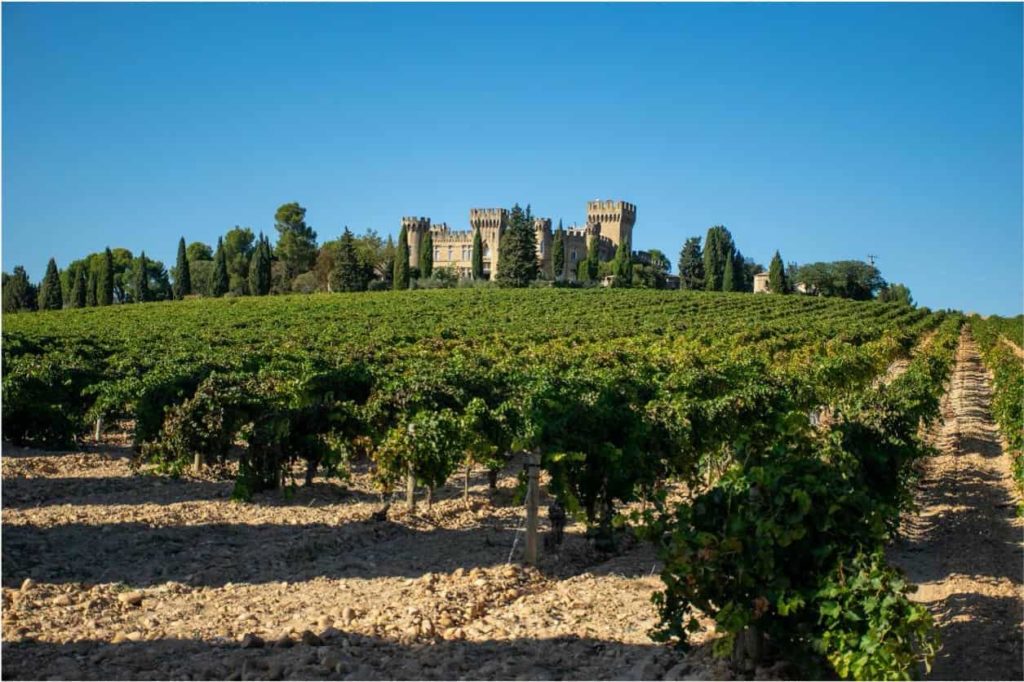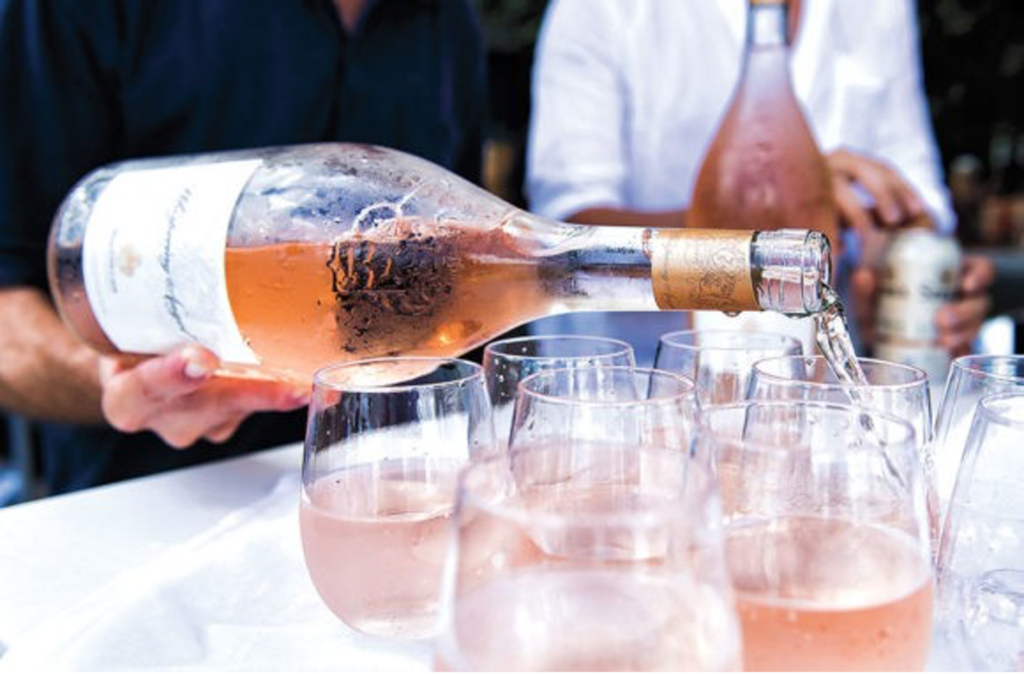
An insider’s guide to Provence rosé

Buoyed by its glamorous image, celebrity cachet and impressive leaps in quality, rosé can scarcely put a foot wrong. New brands continue to enter the market, while rosé has lost none of its appeal among the A-list community. But most importantly: snobbery about rosé has finally been put to rest. Rosé is the ultimate crowd-pleaser, offering superlative quality at attractive prices.
A great deal of excellent rosé wine is made in the dramatic hills of Provence, nestled in a very beautiful part of south-eastern France.
Click on a link to jump to that section:
Geography and terroir
Provence enjoys a quintessential Mediterranean climate, with reliably dry and warm summers (2,800 hours of sunshine a year) and mild winters. Vines thrive in these conditions, yielding high-quality fruit in most years. That said, variances in elevation and situation will create a patchwork of different micro-climates; temperatures are far cooler inland than in the coastal vineyards, particularly at night. In addition, mistral winds from the north help to moderate the balmy summer heat, drying the vines. But overall, a rain-soaked vintage is rare in Provence.
The region also offers a diverse palate of grape varieties, including Grenache, Mourvedre, Carignan,Cinsault, Cabernet Sauvignon, Vermentino, Viognier and Roussannne. Unsurprisingly, the terroir is far from homogenous. It encompasses a great deal of clay/limestone inland, while metamorphic rock is found nearer the coast. The Provençal cliché is garrigue: poor infertile soils (perfect for viticulture) that are covered in a patchwork of lavender, thyme and wild garlic.
In terms of rosé production, the key appellation is Côtes de Provence. Given AOC status in 1977, it is the largest viticultural zone in Provence, encompassing approximately 20,000 hectares of vines. Over 80% of the annual output is aromatic rosé, made across the eastern section of the region. But Côtes de Provence is not limited to one geographical area; there is a great swathe of vines found north-east of Marseilles and Toulon, in addition to the vineyards of Hyeres, La Lavandou and St-Tropez, the latter considered to be France’s most chic resort. Its smaller counterparts are the Côteaux Varois and Côteaux d’Aix-en-Provence appellations, both of which also produce excellent rosé.
Côteaux d’Aix-en-Provence is found north-west of Marseilles, while Côteaux Varois is at the heart of so called ‘calcareous Provence’. It’s an apt title, as the cooler, higher vineyards of the appellation are cultivated on limestone-rich soils. Covering 28 communes situated north of Toulon, the local rosé wines are celebrated for their ripe acidity and freshness. However, a consumer’s point of reference is often brand first, appellation second.
Provence’s rosé revival
The area under vine in Provence is expansive, stretching from just east of Arles to within a touching distance of Monte Carlo. Part of Provence’s charm is the incredible diversity of topography and landscape. Vineyards are planted on the limestone flanks of the Montagne Ste-Victoire, along the Mediterranean coastline and north of the iconic city of Nice. Contemporary Provence is a hotbed of tourism, gastronomy and premium rosé production.
In the 20th century, discerning wine lovers largely ignored Provence, at least outside of the summer season. Although there has been viticulture in this part of the Mediterranean since Greek and Roman times, Provence was not historically associated with fine wine. Rustic reds, heavy rosé and old-fashioned white wines were largely consumed on holiday, and then quickly forgotten.
A surge of investment, coupled with the global rise of the rosé category, has turned the tide. One of the chief architects in revolutionising Provence’s wine culture was Sacha Lichine, who arrived in Provence after selling his father’s property in Margaux. The first vintage (2006) of Chateau d’Esclans was launched to great acclaim, at a time when there was a dearth of good Provençal rosé available in the UK. Today, there are hundreds of premium labels, although Lichine’s signature brand, Whispering Angel, is a clear market leader. Lichine helped to engender a dramatic revaluation of how local rosé should be made, emphasising a lighter colour, fruit-forward aromatics and enticing freshness.

How rosé is made
Massively in vogue, rosé is best described as a light-bodied red wine with a minimum of colour extracted during the winemaking process. All red wines derive their colour from pigments (called anthocyanins) in the skins; a short period of skin contact is responsible for rosé’s pink hue and gentle weight. Rosé is something of a hybrid, merging vinification techniques used to make white and red wine. Growers tend to blend different grape varieties to make their rosé cuvée, often mixing in different proportions of Grenache, Cinsault and Mourvedre. But before that can happen, a set of important stages need to take place. In Provence, rosé will typically be made in one of three different ways, with some inevitable crossover.
Light maceration
This is a very popular method of producing light and elegant rosé. After the harvest, crushed or broken red grapes are chilled to preserve freshness, before being moved to a fermentation tank (often stainless steel). The juice is left in contact with the skins over a short period of time, extracting some colour from the pigments—this is called maceration. The must is then removed from the tank by static draining and cold settled before fermentation. It is then fermented in the same manner as white wine. Many winemakers favour a slow fermentation at temperatures, to produce a very fruity and aromatic rosé style. Certain brands then age their best wines in barrique before bottling, to add texture and mouthfeel. However, this is normally reserved for the more expensive, limited-production cuvées.
Press wine
This method takes it one step further than the maceration technique, as the grapes are not subject to a short maceration before fermentation begins. It involves pressing the bunches immediately, resulting in very pale juice that has enjoyed the bare minimum of skin contact during the procedure. This free-run and lightly pressed must is often chilled before it is run off and fermented in either stainless steel or concrete. Different rosé wines are then blended to produce the final product, before it is filtered and bottled.
Saignée
Winegrowers have been using this method to concentrate their red wines for over a century. Rather unflatteringly, rosé was traditionally viewed as a mere byproduct of saignée, brought to market relatively quickly. The saignée, or ‘bleeding’, technique is distinct from those described above as the fermentation will start while the red grapes are in contact with the must. Simply, it involves fermenting crushed grapes and must for one to three days before the juice is run off (or bled) from the tank. This is then vinified separately as a rosé wine. This method creates a more deeply coloured style of rosé, with greater phenolic extraction.
Enjoying Provence rosé
Rosé is very much a brand-led category. Winemakers in Provence have shown great skill in crafting a high-quality product, regardless of the vintage conditions. As a result, consumers can purchase leading rosé wines with complete confidence, emulating the trust placed in non-vintage (NV) Champagne brands. Miraval, Gavoty, Chateau d’Esclans, Whispering Angel and Mirabeau are among the best premium labels made today.
Such wines are designed to refresh your palate. Good Provençal rosé is mouthwatering, despite being typically dry. The aromas are often characterised by red summer fruits, with bright acidity providing the backbone to an elegant palate of strawberry, mango and citrus. The style can be served all year round, although it is best on a warm summer’s evening. Rosé wine is the ideal aperitif, yet it can also enhance many culinary delicacies, including fresh oysters, bouillabaisse, and salade niçoise.
Rosé has triumphed because the wine is delicious, generally affordable and has an ability to work across a wide range of social occasions. This has given rosé universal appeal, regardless of the hype. Its incredible popularity is more than justified.
Related Pages
An insider’s guide to Côtes de Provence




